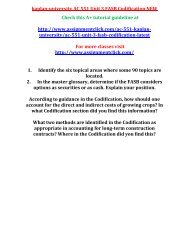DEVRY ECET 370 Week 2 Lab 2
devry ecet 370 week 2 lab 2,devry ecet 370,ecet 370,devry ecet 370 week 2 tutorial,ecet 370 week 2 assignment,devry ecet 370 week 2 help
devry ecet 370 week 2 lab 2,devry ecet 370,ecet 370,devry ecet 370 week 2 tutorial,ecet 370 week 2 assignment,devry ecet 370 week 2 help
Create successful ePaper yourself
Turn your PDF publications into a flip-book with our unique Google optimized e-Paper software.
<strong>DEVRY</strong> <strong>ECET</strong> <strong>370</strong> <strong>Week</strong> 2 <strong>Lab</strong> 2<br />
Check this A+ tutorial guideline at<br />
http://www.ecet<strong>370</strong>assignment.com/ecet-<br />
<strong>370</strong>/ecet-<strong>370</strong>-week-2-lab-2<br />
For more classes visit<br />
http://www.ecet<strong>370</strong>assignment.com<br />
General Instructions<br />
Exercises 1, 2, and 3 use the programs in DocSharinglabeled “User-defined array<br />
list."<br />
Exercise 4 uses the programs in DocSharinglabeled “Using java.util.ArrayList."<br />
Exercise 1: Review of array-based lists Create a project using the classes in the<br />
DocSharing area labeled “User-defined array list." Compile it, run it, and review the<br />
code that is given carefully. This code tests the ArrayList class provided in the<br />
lecture.<br />
Exercise 2: A user-defined array list Modify the class ArrayList given in the lecture by<br />
adding to it the functions listed below for Exercise 2. In each case, the appropriate<br />
error message should be generated if an invalid condition occurs. For example, an<br />
error message should be generated when trying to insert an item in a given location<br />
in the list and the location is out of range. a. ArrayList(int size): create a constructor<br />
that sets the size of the array list to the value passed in size (note that the class<br />
variable SIZE cannot be final anymore). b. int length(): create this function to<br />
determine the number of items in the list (accessor function). c. intgetSize(): create
this function to determine the size of the list (accessor function). d. void clear():<br />
create this function to remove all of the items from the list. After this operation, the<br />
length of the list is zero. e. void replace(int location, int item): create this function to<br />
replace the item in the list at the position specified by location. The item should be<br />
replaced with item. f. void insert(int location, int item): create this function to add an<br />
item to the list at the position specified by location. g. void remove(int item): create<br />
this function to delete an item from the list. All occurrences of item in the list should<br />
be removed. h. int get(int location): create a function that returns the element at<br />
location. i. public ArrayList copy(): create a function that makes a deep copy to<br />
another ArrayList object.<br />
Exercise 3: Using an array-based list Using the class ArrayList completed in the<br />
previous exercise, write a program that uses it to store 100 random numbers.<br />
Consider that each of these random numbers is an integer in the interval [0, 200].<br />
Write the program in such a way that there are no number duplicates.<br />
Exercise 4: Review of the library class java.util.ArrayList Create a project using the<br />
classes in the DocSharing area labeled “Using java.util.ArrayList." Compile it, run it,<br />
and review the code that is given carefully. This code is the complete program given<br />
in our lecture that tests the library class java.util.ArrayList.<br />
Exercise 5: Using the library class java.util.ArrayList Rewrite Exercise 3 (above)<br />
using the class java.util.ArrayList to store the 100 random numbers.


















